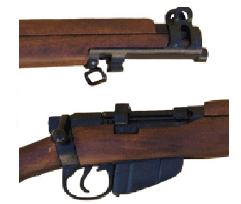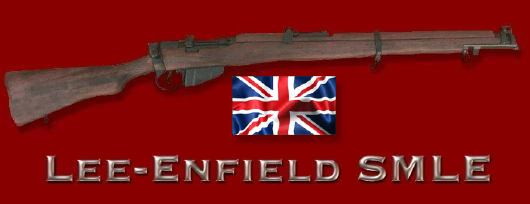Lee-Enfield SMLE. Nothing "smelly" about this Legendary British .303 Caliber Bolt-Action Rifle.

The name Enfield is one of the most respected in military history. The legendary Short Magazine Lee-Enfield can trace its origins all the way back to the famous Brown Bess Muskets of centuries earlier. Though RSAF (Royal Small Arms Factory) was founded in 1816, long after the legendary musket, it was a continuation of the British arms tradition, that has proven itself. The march through time and history brought about the evolution of the later variations of Brown Bess muskets, the BREN, the Bullpup, and the black powder Lee-Metford, to what is regarded by many as one of the most beloved military rifles ever made, the SMLE. Throughout history, the weapons that win wars and save the lives of their carriers are the ones that win people over. The bollt-action loading system was a major advance for its time. Military arms are not so much created anew from scratch as they are developed through years of trial and error, each model arriving as an improvement on a successful predecessor. Generally, in the years leading up to 1907--the years before the Great War and the SMLE entered military service--the rifles were designed for infantry and the carbines for cavalry and others. The SMLE was a form of happy medium of the two. It was not without its critics, but once deployed in combat, proved itself as a worthy firearm.
There were tactical advantages to using the Lee-Enfield SMLE. The rifle's bolt-action and magazine system allowed for rapid repeat firing and reloading with clips, combined wth the accuracy of rifling, and the lightweight portability, further aided the rifle. This enabled troops to surround and neutralize stationary machine gun positions, which became readily apparent to the Germans in the Great War (World War I), forcing them to rethink some of their tactics. This is an almost identical advantage the American troops had with their M1 Garand bolt-action rifle, well into World War II. Some have comparatively deemed the M1 Garand as an "American Enfield." There actually were some SMLEs produced in the US, but more on that later. British troops using well-coordinated bursts of synchronized fire, sometimes tricked the Germans into thinking they were under attack by machine guns. The same can be said of the experiences the Americans had in WWII with their Germans and Japanese adversaries.
A mainstay firearm of both World Wars lasting until 1956, the British Short Magazine Lee-Enfield--best known as the "SMLE" bolt-action rifle has seen action in just about every part of the world. Its origins stem from an older black powder rifle in the 1880's, the Lee-Metford. Emerging as the standard issue infantry rifle for British soldiers in 1907, the SMLE Mk III was in service beyond World War II. It was favored by infantry for its ease of chambering rounds from a short magazine clip.
Use of the SMLE was not exclusive to
British troops. It was also commonly used by Canada, Austrailia, India,
and many nations of the British Commonwealth, and has seen action in
countless military campaigns around the globe. It's still widely used
in India and the developing world, and was still being produced by
Ishpaore of India clear up until the mid 1980s.
The SMLE was jointly produced by several
manufacturers, due to problems meeting the demands of the British
military. The primary factories, RSAF-Enfield (Royal Small Arms
Factory) in the London Borough of Enfield, UK, London Small Arms and
Birmingham Small Arms were pressured to farm out manufacturing to
several other companies. Other facilities also produced the
SMLE. Lithgow Small Arms in Australia, the Longbranch Arsenal
in Canada, Savage Arms in the United States, and Ishapore in India, who
operated in both British Colonial and Post-independence India.
There were some made in Pakistan as well, but some of these
are of ill repute. There is one in particular that should be
avoided; the
infamous Khyber Pass Copies. Produced in the Khyber Pass region near
the Pakistani and Afghani border, these rifles are of inferior quality,
using substandard materials such as soft metals and poorly-fit parts,
most likely produced from inaccurately-copied blueprints. They are
considered unsafe to use, and can fail catastrophically during firing.
Khyber Pass copies can often be identified by examining the markings.
Look for such things as poor quality workmanship and materials,
spelling errors, or a backwards "N" in the word "Enfield." Also, watch
for the stamped designation V.R (Victoria Rex) models dated after 1901.
Queen Victoria died in 1901, so any rifle stamped V.R. should not be
dated after 1901, but rather E.R or G.R. (Edwardius Rex; King Edward
VII or VIII, and Georgius Rex; King George V or VI).

Many of the military
issue SMLE rifles
were converted to sportsmans' r
ifles, or "sporterised" during the
1950's and 1960's. This can be anything from mounting a scope on the
rifle to reworking the ca
l
iber. Often, this was done to meet legal
requirements, or simply to satisfy outdoorsmens' individual tastes.
So many sporterized versions of the SMLE exist that to even
attempt to outline them would require a separate research
project.
Needless to say, I've not heard anyone complaining about
their sporterized Lee-Enfield SMLE. Quite the opposite.
While there are enthusiast groups and many fans of the SMLE
in the UK, there are a large number of those in the United States and
abroad who equally love their "smelly" rifles. Some
enthusiast groups include the "Smelly Shooters",
in New Mexico, USA, the Lee
Enfield Rifle Association in the UK, and many others, world
wide, including countless individual enthusiasts.
Firearm Type: Bolt-Action Rifle
Nation Of Manufacture: UK
Military Service Dates : 1907-1956 (still
in use in developing nations)
Variations: Mk I, Mk II, Rifle No.4,
Jungle Carbine, Sniper Rifle, Civilian Sporterised
Ammunition: .303 Cal. Mk VII SAA Ball
Wars: World War I, World War II, British
Colonial India, Africa, many others
Recent Prices at Auction for Originals: US
$300 to $1,000 Depending on Condition
We offer an authentic replica Lee-Enfield SMLE.